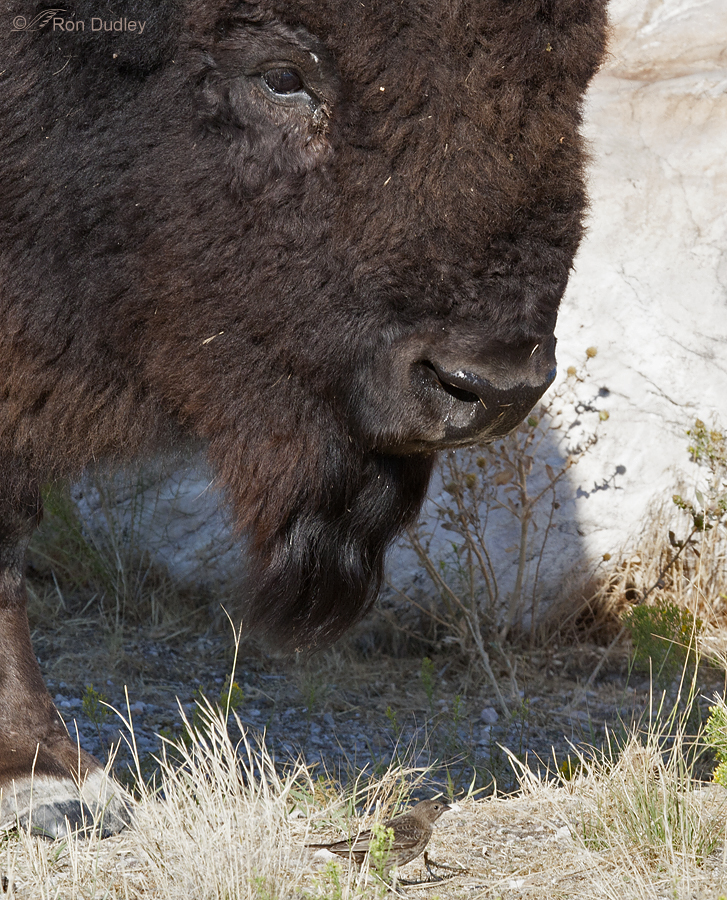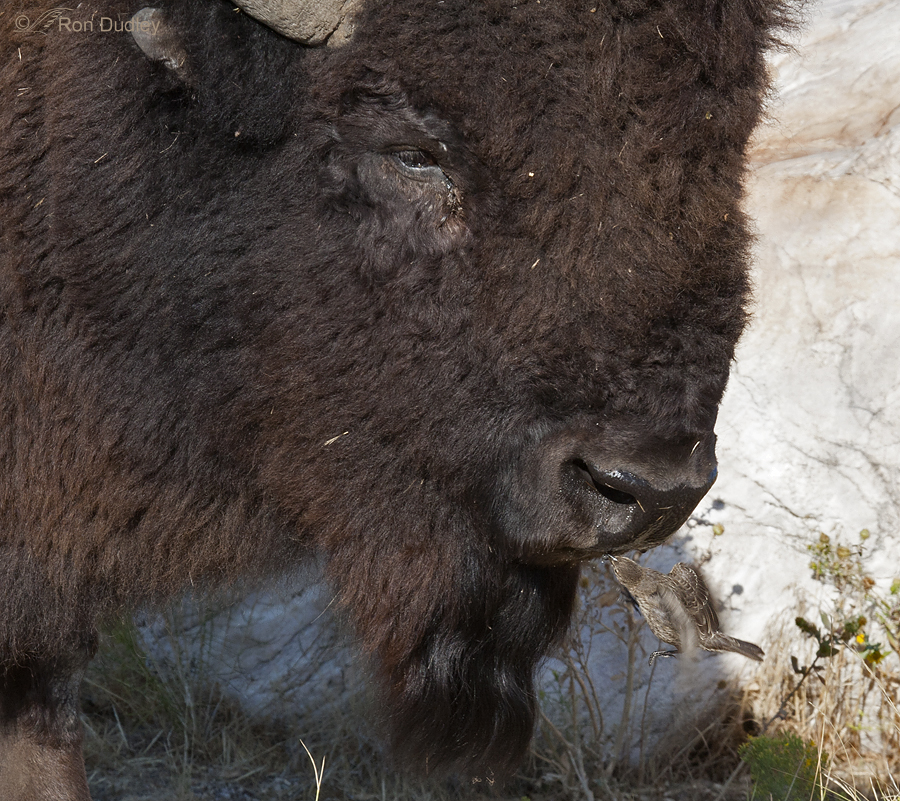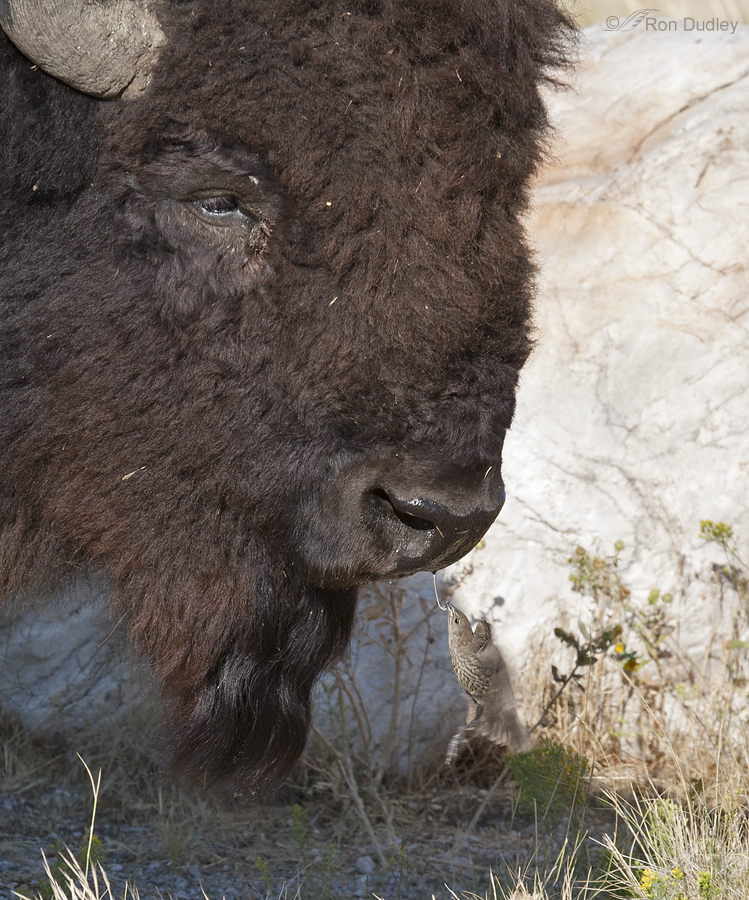Before Europeans came to North America and cleared forests which modified the environment into the agricultural and suburban landscapes of today, the range of the Brown-headed Cowbird was limited to the short-grass plains where they followed the almost endless herds of American Bison as they fed on the insects stirred up by those wandering behemoths. Early settlers so strongly associated them with bison that they were called “Buffalo Birds”.
Today that relationship still exists wherever limited numbers of bison can still be found. Antelope Island is one of those places.
One of the many challenges facing the cowbird was obtaining enough moisture as it followed the bison herds over the hot, rolling plains. In late summer several years ago I photographed a cowbird behavior that illustrated one of the ways they solved that problem.
I found this huge bull languishing in the broiling sun next to a boulder that it had been using as a scratching post. A group of Brown-headed Cowbirds were in the vicinity but at first I wasn’t paying much attention to them. Then this female (at frame bottom) flew in close…
and began flying at the nostrils of the bull. Initially I was unsure about what she was doing but she did it repeatedly and eventually it became clear that she was…
drinking the mucus-laden secretions from the bison’s nostrils. She would actually hover in place as she gobbled down the long, stringy strands of mucus.
Not a pretty sight and perhaps a bit unsettling to our human sensibilities but what an incredibly adaptive behavior for survival in hot, arid conditions.
I love seeing “stuff” like this!
Ron
Note: Apologies for the image quality here. It was mid-day and the light was very harsh so I had to process these images heavily to manage the extreme contrast.





WOW!! Wonderful stuff, many thanks for showing this. I too love these kinds of images.
What a great way to teach animal behavior and ecological adaptation.
Very interesting, Ron. I wonder if the cowbird could be eating the mucus for more than just its moisture content — like, perhaps, excreted minerals? Pure speculation on my part. Great post.
I suppose it’s possible, Marvin. But since it was so very hot that day and I don’t see the behavior on cooler days it’s my suspicion that it was mainly after moisture. Who knows, though…
Wow, Ron, this really took me by surprise! I had no idea. I just have to remember not to think of this image at my next meal. 😉
Good luck with that, Ingrid!
Thank you so much for yet ANOTHER beautiful AND informative post. I am so ignorant that I hadn’t realised that there were still bisons – much less of this wonderful adaptive behaviour. From sucker fish to dung beetles to cow-birds there is not a lot of waste in the natural world. Another thing we would benefit from emulating.
Elephant’s Child, American Bison came extremely close to extinction – there may have been as few as 541 individuals left when a group of ranchers gathered the few remaining animals and attempted to rescue the species. There are some genetic issues with today’s animals that have resulted from such a small gene pool but today there are quite a few of them. The Antelope Island herd numbers about 500.
I’m sure that your lack of knowledge of the bison pales in comparison to my ignorance of your Australian marsupials amd other unique wildlife.
If this sort of thing was taught in elementary schools, we would have kids lining up to become scientists!
Thank you, Ron!
Loved what you said about elementary schools and “this sort of thing”, Wally. Thank you.
Fun, gross, cool, wonderful!
Thanks, Scott. Loved all four “descriptors”.
Once again: I had no idea! thank you for this informative and startling blog. Life is stranger than fiction.
Tana, knowing what a skilled observer of nature you are I’ll admit that it pleases me whenever I manage to come up with something that’s new to you.
Nature has uses for everything; we on the contrary have had to go great lengths to “learn” innovative technology on how to “recycle” and “save” earth. Isn’t that something? Hehe.
Maria, nature uses its resources well when left to its natural rhythms, that’s for sure.
Heavily processed or no, they are gorgeous shots! Had you known of this behavior before you caught it that day?
No, I hadn’t, Chris – although I do have a vague memory of “some kind of birds” hanging around the nostrils of cows when I was a kid on a Montana farm.
Ron your “work” is amazing! Not only are your photos top drawer, but your insights and information are fantastic!
I don’t often comment, but i view you stuff daily.
Don’t stop doing what you’re doing!
I won’t, Chuck. Thanks for the encouragement.
Awesome! I love seeing stuff like that, too! Surprises are such fun! Great that you captured it!
Thanks, Dawn. You just never know what you’re going to see when you’re “out there”.